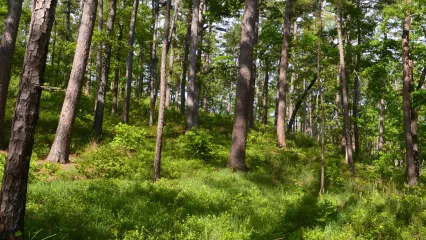Red-cockaded woodpeckers and their specialized habitat needs are a major consideration for biologists at the McCurtain County Wilderness Area – the Wildlife Department’s oldest management area and home to Oklahoma’s last remaining population of the federally endangered bird. But management efforts for the rare woodpecker have also benefited a host of other Oklahoma wildlife.
The 14,000-acre McCurtain County Wilderness Area, located in extreme southeastern Oklahoma, is the largest patch of mature shortleaf pine-hardwood forest remaining in the nation. Towering pine trees mingle with a variety of oaks, hickories and other hardwoods on the area’s sometimes steep slopes, and grasses and wildflowers flourish at ground level. Management plans focus on maintaining this park-like setting of scattered pine trees preferred by the woodpecker.

“The open habitat allows the birds to quickly maneuver while foraging and evading predators,” said Clay Barnes, wildlife biologist stationed at the Wilderness Area. “It also provides security for their nest cavities. In an open setting, snakes – a major nest predator of the endangered woodpecker– don’t have the ease of access to the woodpecker’s cavities as they do when neighboring trees and overlapping branches provide a connect-the-dots pathway to the nest.”
The scattered trees and lush understory also provides habitat for a variety of other wildlife. “When we provide habitat for the woodpeckers, we’re providing habitat for a number of other species from insects, to turkey and quail, to deer.”
After years of active management, both biologists and hunters have noticed an increase in game and nongame species. “Surveys have shown a positive response in many songbirds, and deer and turkey hunters regularly observe and harvest their game as part of the area’s limited controlled hunts program.”
The recipe behind the open habitat and resulting wildlife boost? Biologists like Barnes and his predecessors have been applying prescribed fire across the Wilderness Area on a three-year rotation. “We know the area has had a long fire history, both from natural lightning fires and man-made fires started by Native Americans. We’re just continuing that history.”
The well-planned fires help set back the annual vegetation growth – especially of hardwood saplings. Each year, at least one of the area’s three burn units is subject to prescribed fire, which encourages grasses and other seed-producing plants to grow, and allows the shortleaf pines lying dormant in the seed bank to germinate.
Some years, the annual rainfall stimulates so much hardwood regrowth that the three-year fire rotation can’t be as effective as needed. Small chainsaw crews help manage the regrowth until fire returns to the unit.
“When we open up the canopy – either through continued prescribed burning efforts or through hardwood thinning – it gives rise to a lot of insects that the red-cockaded woodpecker and other forest birds feed on.”
“I see the bulk of wildlife in areas where thinning is most evident. You can see the difference – in the plant community and wildlife community – by just looking across the boundary fence in some areas. The management efforts have really given the area life.”